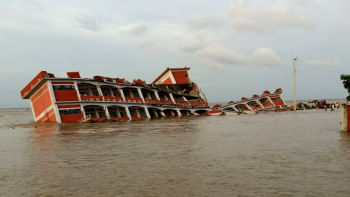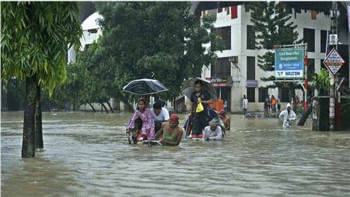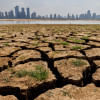Kurigram flood victims need urgent support

It is worrying to see the flood situation in northern districts, especially in Kurigram, worsen due to continuous rainfall and onrush of water from upstream. According to a report by this daily, vast low-lying areas have been inundated due to the rise in the water levels of Teesta, Brahmaputra, Dharla, and Dudhkumar rivers. In Kurigram, along the Brahmaputra, some 450 chars and low-lying areas have been flooded, leaving an estimated 50,000 stranded. This is a fluid situation as the water level is projected to continue rising before it recedes. What this means for the affected and at-risk populations is that they have a dual crisis in hand—flooding and erosion—which demands proper attention from the authorities.
The evolving situation in these districts, with the simultaneous rise and fall in water levels at different river points, and consequent erosion along their coast, is something the authorities should be observing closely, considering the intensity of such events in recent years. But the immediate priority, of course, is to ensure proper relief efforts. Reports indicate a significant gap between the needs of the affected and available aid. Many flood victims are struggling without adequate relief supplies. Lack of shelter is another major issue, especially in parts of Lalmonirhat and Kurigram where floodwater is showing a falling trend. As per a report, erosion is active at 20 points in five upazilas of the two districts. As a result, many villagers are taking shelter on government khas lands, roads, boats, or embankments. Ensuring that relief materials, including food, clean water, and medical supplies, promptly reach them all is imperative.
The increasingly frequent cycle of flooding and erosion in Bangladesh also demands a proper response from the higher authorities. There is a clear need for more resilient infrastructure in flood-prone areas that doesn't make people so helpless, or destitute overnight. While erosions occur every year, its growing trend, especially along the Ganges, Jamuna, Padma, and Lower Meghna rivers, highlights the urgency of more comprehensive and long-term interventions, such as enhancing drainage systems, constructing sufficient flood shelters, reinforcing embankments with durable materials, and regulating river flows.
In short, the government's approach needs to be twofold: immediate stabilisation of the most critical areas and the development of a comprehensive, sustainable plan to mitigate the impacts of future floods. For now, it must direct local authorities to improve their response to the evolving situation in northern districts. Besides ensuring sufficient relief materials in flood-hit villages, particularly those in remote locations, they should also consider deploying additional resources and personnel to manage the crisis more effectively.


 For all latest news, follow The Daily Star's Google News channel.
For all latest news, follow The Daily Star's Google News channel. 










Comments